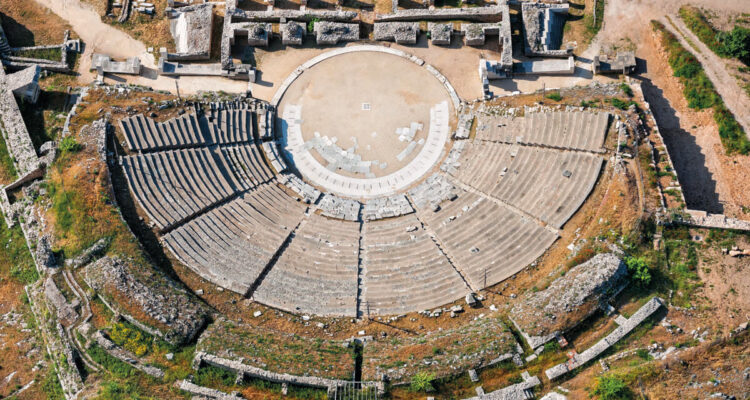The area of Philippi is associated with outstanding historical figures and events that shaped Western civilization. Unique monuments, preserved to this day, bear witness to the centuries-old history of cultures that intersected and developed in the area.
The ancient city of Philippi was originally (360 BC) a colony of the Thasians, under the name Krinides. Soon, however, it was conquered by the then powerful Philip II, king of Macedonia, who fortified the city and gave it his name.
In the Hellenistic years, the city acquired its wall, the theater, public buildings and private residences. Undoubtedly, the most impressive building of this era, despite the changes it underwent over the centuries, is the Ancient Theater of Philippi, which every summer hosts a part of the Philippi Festival.
In the 2nd century BC, the passage of the Egnatia Road through Philippi, one of the greatest military and commercial roads of the ancient world, turned the city into a point of reference in the region.
However, the most important event in Roman times, which indelibly stamps the history of the city, is the battle of Philippi in 42 BC, when the democratic Romans, with generals Brutus and Cassius, face the followers of the Monarchy under Mark Antony, Octavian (later Caesar Augustus, first Roman Emperor) and Lepidus. The democrats lose, their leaders commit suicide and the imperial period of rule begins for Rome.
The arrival of the Apostle Paul marked the establishment of the first Christian church on European soil in 49-50 AD. The prevalence of the new religion and the transfer of the capital of the Roman state to Constantinople brought glory to the Philippi. During the early Christian years (4th-6th centuries AD), the “Octagon” complex was founded, in place of the Roman buildings, with the metropolitan church dedicated to the Apostle Paul, the “Bishop’s Palace”, as well as three magnificent basilicas and private residences.
The city begins to be abandoned at the beginning of the 7th AD. century, due to great earthquakes and Slavic raids. It survived the Byzantine years, as a strong fortress, but its desolation was completed with the Turkish conquest at the end of the 14th century.
Excavation research began in Philippi in 1914 by the French School of Archeology. After World War II, the Archaeological Service and the Archaeological Society carried out systematic excavations. Today the Archaeological Service, the Aristotle University of Thessaloniki and the French School of Archeology continue the archaeological research. The findings of the excavations are kept in the Archaeological Museum of Philippi.
Since July 2016, the archaeological site of Philippi has been included in the list of UNESCO World Heritage Sites.
Copyright 2023 © Created By Diadyktio, All Rights Reserved.
To provide the best experiences, we and our partners use technologies like cookies to store and/or access device information. Consenting to these technologies will allow us and our partners to process personal data such as browsing behavior or unique IDs on this site and show (non-) personalized ads. Not consenting or withdrawing consent, may adversely affect certain features and functions.
Click below to consent to the above or make granular choices. Your choices will be applied to this site only. You can change your settings at any time, including withdrawing your consent, by using the toggles on the Cookie Policy, or by clicking on the manage consent button at the bottom of the screen.

Congratulation!